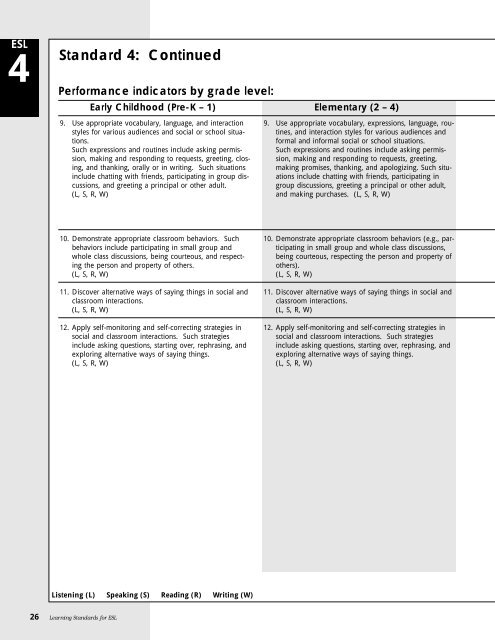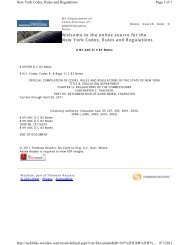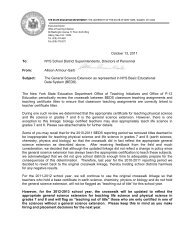ESL Learning Standards - Higher Ed - New York State Education ...
ESL Learning Standards - Higher Ed - New York State Education ...
ESL Learning Standards - Higher Ed - New York State Education ...
Create successful ePaper yourself
Turn your PDF publications into a flip-book with our unique Google optimized e-Paper software.
<strong>ESL</strong><br />
4<br />
Standard<br />
4: Continued<br />
Performance indicators by grade level:<br />
Early Childhood (Pre-K – 1) Elementary (2 – 4)<br />
9. Use appropriate vocabulary, language, and interaction<br />
styles for various audiences and social or school situations.<br />
Such expressions and routines include asking permission,<br />
making and responding to requests, greeting, closing,<br />
and thanking, orally or in writing. Such situations<br />
include chatting with friends, participating in group discussions,<br />
and greeting a principal or other adult.<br />
(L, S, R, W)<br />
9. Use appropriate vocabulary, expressions, language, routines,<br />
and interaction styles for various audiences and<br />
formal and informal social or school situations.<br />
Such expressions and routines include asking permission,<br />
making and responding to requests, greeting,<br />
making promises, thanking, and apologizing. Such situations<br />
include chatting with friends, participating in<br />
group discussions, greeting a principal or other adult,<br />
and making purchases. (L, S, R, W)<br />
10. Demonstrate appropriate classroom behaviors. Such<br />
behaviors include participating in small group and<br />
whole class discussions, being courteous, and respecting<br />
the person and property of others.<br />
(L, S, R, W)<br />
11. Discover alternative ways of saying things in social and<br />
classroom interactions.<br />
(L, S, R, W)<br />
12. Apply self-monitoring and self-correcting strategies in<br />
social and classroom interactions. Such strategies<br />
include asking questions, starting over, rephrasing, and<br />
exploring alternative ways of saying things.<br />
(L, S, R, W)<br />
10. Demonstrate appropriate classroom behaviors (e.g., participating<br />
in small group and whole class discussions,<br />
being courteous, respecting the person and property of<br />
others).<br />
(L, S, R, W)<br />
11. Discover alternative ways of saying things in social and<br />
classroom interactions.<br />
(L, S, R, W)<br />
12. Apply self-monitoring and self-correcting strategies in<br />
social and classroom interactions. Such strategies<br />
include asking questions, starting over, rephrasing, and<br />
exploring alternative ways of saying things.<br />
(L, S, R, W)<br />
Listening (L) Speaking (S) Reading (R) Writing (W)<br />
26 <strong>Learning</strong> <strong>Standards</strong> for <strong>ESL</strong>
















